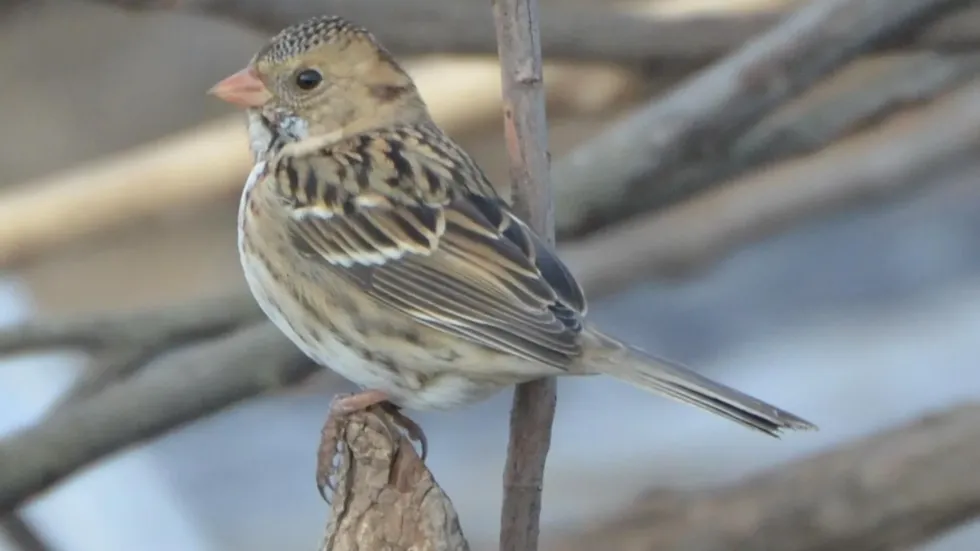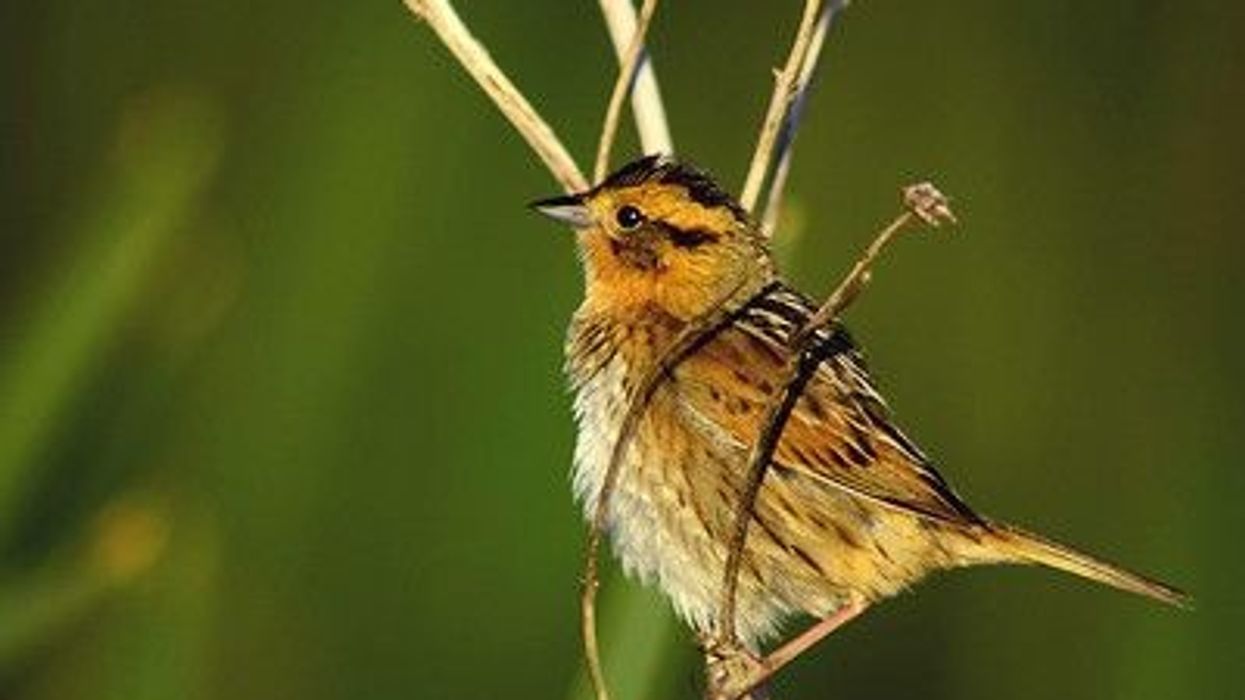The Harris's sparrow (Zonotrichia querula) belongs to the family Passerellidae. It has two distinct ranges, the range where breeding occurs consists of north-central Canada, forests, tundra regions of Manitoba, Ontario, and also the northwest territories.
The winter season is spent in a range that includes South Dakota and Texas. It is occasionally known to be found in Ontario, Florida, and California too.
The habitat of Harris's sparrows consists of mixed forests and tundra regions. They look for shrubby vegetation for shelter purposes for their nest near the southern Great Plains and mating takes place in coniferous and boreal forests.
The reproduction of this species begins when males and females arrive at the breeding grounds. In around seven days, breeding pairs are formed and the mating takes place between late May to early June and might go on until August.
The eggs are laid around 14 days after arriving at the breeding site. About three to five eggs per clutch are laid. The eggs take about 13-14 days to hatch and fledging takes place after eight and a half to 10 days.
Harris's sparrow (Zonotrichia querula) is known to have a black crown and a pink bill. The winter plumage of these birds is known to be brown overall with buffy cheeks and the non-wintering plumage is known to have patches that are black-colored on the throat and crown and gray cheeks.
These sparrows are often confused with another species that is similar in appearance, that is the Lapland longspur. The diet of Harris's sparrows consists of fruits, seeds, conifer needles, and arthropods like ants, bees, flies, moths, spiders, cicadas, butterflies, and aphids.
Their food only consists of seeds and fruits during winter and migration. These sparrows are placed under the Near Threatened category of conservation.
It is quite fascinating to learn more about this species and if you are interested, you can also read about the American tree sparrow and the grasshopper sparrow, too.
Harris's Sparrow Interesting Facts
What type of animal is Harris's sparrow?
Harris's sparrow is a bird.
What class of animal does Harris's sparrow belong to?
Harris's sparrow belongs to the class of Aves along with all other birds.
How many Harris's sparrows are there in the world?
The breeding population of this population is known to be around 2 million.
Where does Harris's sparrow live?
The wide Harris's sparrow range consists of both a breeding and non-breeding range. The breeding range consists of north-central Canada, forest-tundra regions of Manitoba, Ontario, and also the northwest territories.
The winter or the non-breeding season is spent on wintering grounds in a range that includes South Dakota and Texas. This bird is occasionally known to wander in Ontario, Florida, and California too.
What is a Harris's sparrow's habitat?
The habitat that these birds inhabit during the breeding season consists of mixed forest-tundra areas. They look for shrubby vegetation for shelter purposes for their nest near the southern Great Plains.
Breeding takes place in coniferous and boreal forests or in stunted boreal forest habitats. They can be spotted feeding in agricultural fields, scrubby hedgerows, and pastures. They are also known to migrate through woodland edges and dense riparian thickets.
Who do Harris's sparrows live with?
These birds can be spotted in flocks during migration but they are known to be solitary otherwise.
How long does Harris's sparrow live?
Their lifespan recorded in the wild is known to be around 11 years and eight months.
How do they reproduce?
After migration, males and females are known to arrive at the breeding grounds and establish their territories straight after arriving. Within seven days, the pairs are formed and the nest is built on grounds near shrubby vegetation.
Breeding begins around mid-June. The breeding system of these birds is known to be monogamous, but the bond length between each pair is unknown.
Breeding takes place around late May to early June and might go on until August. The eggs are laid around 14 days after arriving at the breeding site and around three to five eggs per clutch are laid.
In around 13-14 days, the eggs hatch, and the fledging of the chicks take place after eight and a half to 10 days.
After two more weeks, these young chicks become independent. Before the young chicks become independent, both parents feed the chicks.
What is their conservation status?
This bird species is placed under the Near Threatened category when it comes to its conservation status.
Harris's Sparrow Fun Facts
What do Harris's sparrows look like?
Harris's sparrows are known to have a black crown and a pink bill. Their bib is known to vary in color depending on the season and the age of the bird.
The typical Harris's sparrow winter plumage is known to be brown overall and this winter plumage has a black-colored throat and buffy cheeks. They are occasionally known to have white bands and a white belly too.
Breeding sparrows have a breeding plumage that consists of black-colored patches on the throat and crown and gray cheeks.
Young Harris's sparrow birds are known to have a similar appearance to non-breeding adults, but they also have a dark band on the breast, a white throat, and a dark malar stripe. Due to the non-breeding plumage of these birds, they might sometimes be confused with the Lapland longspur, a similar species.
How cute are they?
These birds are considered cute because of their small size. A young immature Harris's sparrow is certainly adorable!
How do they communicate?
Just like other bird species, Harris's sparrows also various sounds and calls to communicate with each other.
How big is Harris's sparrow?
The length of Harris's sparrows ranges from 6.7-7.9 in (17-20 cm). These birds are similarly sized or larger than the fox sparrow and chipping sparrow.
How fast can Harris's sparrow fly?
The exact speed of Harris's sparrows in flight is unknown.
How much does Harris's sparrow weigh?
The weight range of Harris's sparrows is around 0.92-1.73 oz (26-49 g).
What are the male and female names of the species?
Males and females of this species do not have any particular names.
What would you call a baby Harris's sparrow?
Baby Harris's sparrows are referred to as chicks or juveniles.
What do they eat?
The diet of Harris's sparrows consists of fruits, seeds, conifer needles, and arthropods like ants, bees, flies, moths, spiders, cicadas, butterflies, and aphids. Their diet only consists of seeds and fruits during winter and migration. These birds are known to be ground feeders and kick at the vegetation around them, hoping for seeds and fruits to fall out.
Are they dangerous?
These birds are not considered dangerous.
Would they make a good pet?
Not much is known about these birds as pets, but it is believed that these birds would not make great pets as they are wild and migratory birds.
Did you know...
Harris's sparrow is known to be the largest sparrow in North America.
The genus Passer is known to have about 25 species of sparrows.
This sparrow species was named by John James Audubon to commemorate Edward Harris, an American amateur ornithologist.
These sparrows are known to sing from high perches. This song is known to consist of one or more high wavering whistles which are followed by other sounds in either a high or low pitch. Their sound is described as a metallic chink. Males of this species often gather in a group to sing together at dusk.
The oldest male is known to have the largest bib and it is known to be the most dominant. Males are also known to engage in jump fights by leaping, pecking, beating, and clawing at each other.
It has been recorded that the first male winter bird (that has its feathers dyed black, which creates a large bib) is higher up in the group's hierarchy than other young males and females.
Predators of the nest include northern shrikes, merlins, and Canada jays. The great-horned owl and sharp-shinned hawks are also predators of the wintering sparrows.
The Harris's sparrow's breeding process
After migration, males and females are known to arrive at the breeding grounds and establish their territories straight after arriving. Within seven days, the pairs are formed and the nest is built on grounds near shrubby vegetation.
Breeding takes place around late May to early June and might go on until August. The eggs are laid around 14 days after arriving at the breeding site and around three to five eggs per clutch are laid.
What is special about sparrows?
Sparrows are considered special birds as they are known to have particularly beautiful voices and their songs and chirping are known to be heard all over. Sparrows are also known to be found close to humans. Their round heads are also considered to be special and unique.
Here at Kidadl, we have carefully created lots of interesting family-friendly animal facts for everyone to discover! Learn more about some other birds from our myna bird facts and mountain bluebird facts.
You can even occupy yourself at home by coloring in one of our free printable Harris's sparrow coloring pages.










